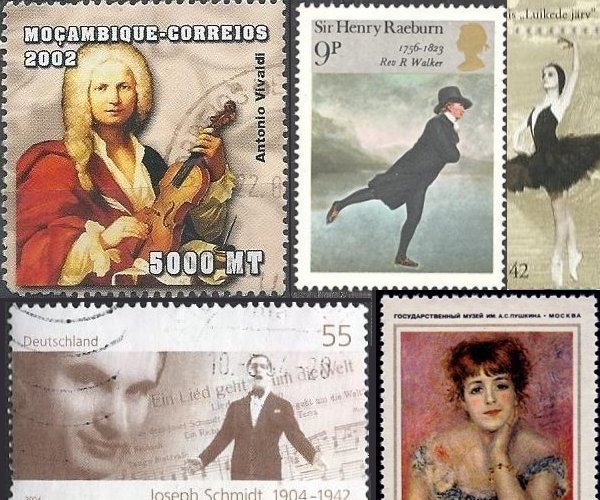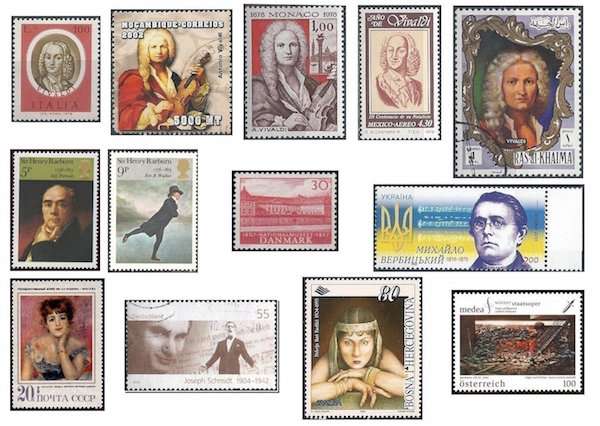The Arts on the Stamps of the World — March 4
An Arts Fuse regular feature: the arts on stamps of the world.

By Doug Briscoe
For the 4th of March we acknowledge the birthdays of Antonio Vivaldi, Sir Henry Raeburn, and several more, as well as the death anniversary of Hans von Aachen and the 140th anniversary of the première of Swan Lake.
As late as 1969, Vivaldi’s birth date was unknown, I guess, because one of the first LPs I bought around that time, an RCA album of Vivaldi’s Four Seasons with Salvatore Accardo, had the following note: “The date of his birth has been tentatively set between 1675 and 1678 by counting back from the year of his ordination in the priesthood.” Now we know he was born on 4 March 1678. He died in 28 July 1741. I have Vivaldi stamps from Italy (natch), Mozambique and Monaco (my favorites), Mexico, and the United Arab Emirate of Ras al Khaima.
One of the lead portrait painters of eighteenth-century Britain, Sir Henry Raeburn (4 March 1756 – 8 July 1823) was born near Edinburgh (actually, in a village that today is part of Edinburgh), orphaned in early childhood, and apprenticed to a goldsmith. He started painting miniatures and graduated to oils. In a rags-to-riches development, he married the rich young widow of a count. Sir Joshua Reynolds gave him letters of introduction for his further studies in Rome, and rather than succumb to the draw of the bright lights, he chose to settle in his native Scotland, where he (distantly) served George IV and went on to produce a thousand paintings. The UK stamps of 1973 give us Raeburn’s Self-Portrait (c1815) and his charming The Reverend Robert Walker Skating on Duddingston Loch, familiarly known as The Skating Minister (1790s).
The work of Danish architect Lauritz de Thurah (1706 – 5 September 1759) can be seen on at least one stamp, showing the façade of Roskilde Palace (aka the Yellow Mansion), but it’s a monotone issue that doesn’t transmit the, uh, yellowness of the original. His masterpiece, though, is considered to be the spire of Our Saviour’s Church in Christianshavn. Born Laurids Lauridsen de Thurah, he was largely self-taught as an architect who learned much of his craft with his travels on a royal grant in Germany, Italy, France, Holland, and England. But his absorption of the Baroque style did not equip him for changes in taste, and in later life he lost commissions to other architects who had taken to the new Rococo manner. Thurah also wrote architectural treatises.

Ukrainian composer Mykhaylo Verbytsky (1815 – December 7, 1870) was born in what was then Austria-Hungary (now Poland). Orphaned at the age of ten, he was taken in by his uncle, an intellectual who founded a cathedral choir and music school as well as the first Ukrainian language printing press in his city of Peremysl. Verbytsky learned the guitar, his favorite instrument, and later wrote a textbook on how to play it. He became a priest, like his father (the uncle was a bishop). Besides his works for guitar, he wrote some 67 sacred and secular choral pieces, music to twelve works for the stage, nine (or twelve?) works he called symphonies (really more like overtures), and an alternate melody to the song “Shche ne vmerla Ukrainy” (“Ukraine’s glory has not perished”), which was later adopted as the national anthem of Ukraine (in 1917 and again in 1992).
Although she achieved fame in her own time as a distinguished actress, Jeanne Samary (1857 – September 18, 1890) is probably best known to us as a favorite subject of Auguste Renoir, who painted her around a dozen times. (She was also twice painted by Louise Abbéma.) Samary was especially celebrated for her roles in comedies. She wrote a children’s book, Les gourmandises de Charlotte, and died of typhoid fever at age 33.
Romanian Jewish tenor and actor Joseph Schmidt (1904 – November 16, 1942) died as a result of, if not actually “in” the Holocaust. Born in Bukovina province (part of Romania after World War I, today Ukraine), his first language, typically for many born into the vast multicultural mix of Austria-Hungary, was German, but he soon learned Yiddish and Hebrew and later became fluent in Romanian, French, and English. As a boy alto he sang in the Czernowitz Synagogue. His big “break” came in 1929, when he was invited to sing in a Berlin radio broadcast of Meyerbeer’s L’Africaine. He took part in many other broadcasts, and his beautiful voice can be heard in a considerable number of recordings, although with his very small stature (4′ 11″) he couldn’t follow a career on the opera stages of the day. With the “magic” of film, however, he appeared in several movies in both German and English. He undertook a tour of the US, including a Carnegie Hall appearance, in 1937. Stranded in Brussels when the war broke out, he made an unsuccessful attempt to escape to Cuba, but did finally manage to get into Switzerland, where he was interned at a refugee camp near Zürich. By then, however, his health had been weakened, and he died two days after being released from a hospital stay for a throat infection.
Another singer born on exactly the same day as Schmidt was Bahrija Nuri Hadžić (1904 – 24 October 1993), a great Bosnian soprano. Born in Sarajevo to the writer Osman Nuri Hadžić, she grew up in Mostar, but her father moved the family to Belgrade so as to secure for her a better musical education. On the recommendation of her singing professor, Bahri progressed to the Academy of Music in Vienna. On graduation she accepted an offer to join the opera company in Bern, Switzerland and went on to a distinguished European career. In 1937 she took title role in the première of the unfinished version of Alban Berg’s Lulu. Richard Strauss himself is said to have regarded her Salome as the best and most beautiful when he conducted a performance with her in 1939.
It was just a few days ago that I posted the image of this Austrian stamp for the Vienna State Opera. February 28 was the seventh anniversary of the first performance of the opera Medea, and today is the birthday of its composer Aribert Reimann (born 1936). He was born and studied in Berlin, worked as a répétiteur, teacher, and pianist, and has made a number of recordings as an accompanist, at least one with Dietrich Fischer-Dieskau, for whom Reimann wrote his opera Lear. He turns 91 today.

The Ukrainian pop singer Volodymyr Ivasyuk (1949 – 18 May 1979) came to fame with his song “Chervona Ruta” (“Red Rue”) from 1970. This hit song went on to feature in a film of the same name. He is also credited with the first Soviet rock-opera. Ivasyuk played violin and piano at a very early age and formed an ensemble at his school for which he wrote his first songs. Not your ordinary, run-of-the-mill pop star, he also studied and practiced medicine (pathological physiology). He was only thirty when his body was found hanging in a forest near Lviv. The case was officially listed as a suicide, but it seems some doubt remains.
In this series we have yet to pay tribute to a fashion designer. Today we have our first, Édouard Vermeulen (born 1957), founder of the label Natan and famous for his sartorial designs for the Benelux royal families. He has a boutique in Brussels. The recent stamp is not for Vermeulen per se, but rather for the Natan line.
We don’t know the birthday of German Mannerist painter Hans von Aachen (born 1552), but he died on this date in 1615. He is probably best known for his mythological subjects, but painted in a variety of genres. He was born in Cologne (his father in Aachen, thus the name) and had his early training there, then moved as a young man to Venice, where he remained with other expat Northern painters from 1574 to 1587, with excursions to Rome and Florence. While in the latter city he was commissioned to do portraits for the Medici. Returning to Germany, he was first at Augsburg, then Munich, where he served Duke William V of Bavaria and married the daughter of the great composer Orlando di Lasso. Von Aachen’s next port of call, so to speak, was Prague, where he was in the service of Emperor Rudolf II, in particular, making portraits of Rudolf’s potential brides. This required much travel, but von Aachen ended his days in Prague, having been retained by Rudolf’s successor Matthias I. The Slovakian stamp shows a detail from his 1587 canvas The Carrying of the Cross.
My favorite ballet, Tchaikovsky’s Swan Lake, was premièred on this date (O.S. 20 February) in 1877 at Moscow’s Bolshoi Theatre to choreography by Julius Reisinger. As distinct from the many Tchaikovsky stamps in existence, Swan Lake has itself been represented on quite a number of stamps from around the world: Russia (at least four times), Austria, Cuba, Estonia, Germany, New Zealand, Sweden, and probably some others I don’t know about.
Somewhere there is probably a stamp for Japanese master painter Kano Tan’yu (4 March 1602 – 4 November 1674), but I can’t find one. And I can’t help mentioning with a smile one of my favorite actresses, Joan Greenwood (4 March 1921 – 28 February 1987).
A graduate of the University of Massachusetts with a B.A. in English, Doug Briscoe worked in Boston classical music radio, at WCRB, WGBH, and WBUR, for about 25 years, beginning in 1977. He has the curious distinction of having succeeded Robert J. Lurtsema twice, first as host of WGBH’s weekday morning classical music program in 1993, then as host of the weekend program when Robert J.’s health failed in 2000. Doug also wrote liner notes for several of the late Gunther Schuller’s GM Recordings releases as well as program notes for the Boston Classical Orchestra. For the past few years he’s been posting a Facebook “blog” of classical music on stamps of the world, which has now been expanded to encompass all the arts for The Arts Fuse.
